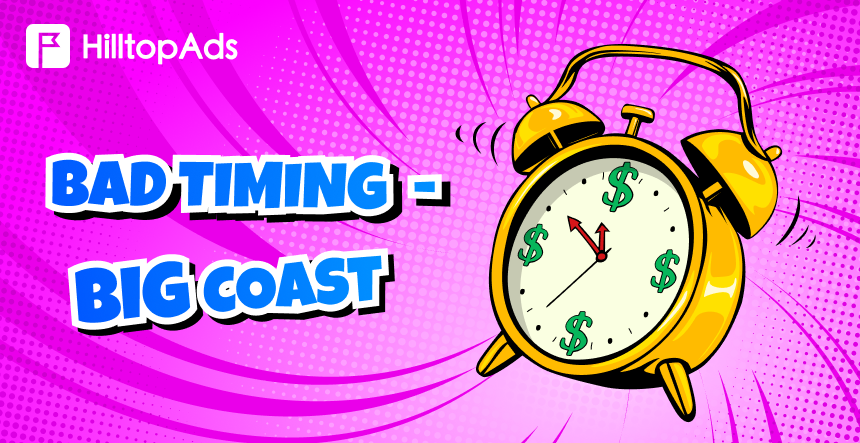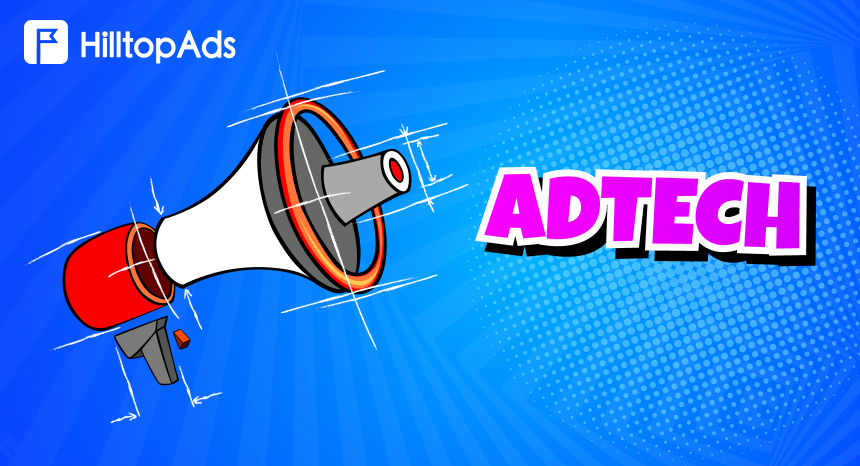In digital marketing, a key question is how many times an ad should be shown to the same user. Too few exposures may cause a customer to miss the ad, while too many can lead to “banner blindness” or irritation, reducing engagement. Understanding how the number and timing of exposures affect the conversion rate (CR) — the share of users who complete a target action, such as a purchase or registration — is essential.
In this article, we analyzed data from CPA (Cost Per Action) campaigns, where advertisers pay only for completed actions, using real campaign data collected over two weeks. Our goal was to identify patterns in how conversions change depending on the interval between consecutive impressions to the same user. These findings provide practical guidance for optimizing ad frequency and testing new strategies.

Start working with HilltopAds to
put the research insights into practice right away.
How we Measured the Impact of Ad Timing
Our analysis included data from CPA campaigns over a two-week period. To account for the frequency effect, we selected users who saw the ad again within three minutes of a previous impression. Unique users were identified by combining the IP address with the User-Agent (UA) string. This approach helps reliably capture repeated impressions that occur in short time intervals.
For each repeated impression, we calculated the elapsed time since the previous impression to the same user. We then grouped the data by these time intervals and computed the total number of impressions and conversions in each interval. From these values, we calculated CR as the ratio of conversions to impressions. The resulting graph of CR versus time since the previous impression was smoothed using a moving average to better reveal the overall trend.
This methodology allowed us to chart how user response (CR) depends on the pause between ad impressions to the same user.
Decoding the CR Curve: Timing Insights
The resulting CR-vs-time graph can be roughly divided into three main ranges:
0–15 seconds
With very short intervals between impressions (a few seconds up to about 15 seconds), conversion rises sharply. Initially, CR is low, but as the pause increases to 15 seconds, we observe a rapid jump in conversions.
15–60 seconds
In this range, CR reaches its maximum values and remains at the peak. In other words, a repeat impression 20–30 seconds after the previous one shows the highest effectiveness. Overall, in the 15–60 second window, conversion is high and stays almost constant.
Above 60 second
Once the interval reaches about one minute, conversion falls noticeably (by roughly one-third) and then gradually decreases further as the gap grows. In fact, later repeats (more than a minute after the previous impression) become less effective compared to the optimal 20–30 second window.
Thus, our study revealed a clear relationship between ad frequency and conversion probability: extremely frequent ads (pauses under 5 seconds) yield the lowest CR, while the optimal response comes from repeat exposures after 20–30 seconds. The main observations can be summarized as follows:
- At intervals under 15 seconds, conversion increases rapidly as the pause lengthens (i.e., very fast repeats become increasingly effective up to about 15 seconds).
- In the 15–60 second range, conversion is at its highest and remains consistently high (peak advertising impact).
- After one minute, CR drops by roughly one-third and then gradually declines further (additional repeats beyond this point start losing effectiveness).
These results clearly demonstrate that impression frequency has a significant impact on the effectiveness of CPA campaigns.
Run your ads with HilltopAds to maximize conversions and gain access to
- Advanced targeting options
- Direct traffic sources
- Self-serve platform
- Fully-managed service
- Postback tracking
Finding the Golden Mean
These patterns can be explained by advertising perception psychology and budget optimization. With extremely frequent ads (gaps under 5 seconds), the user simply doesn’t have time to process the previous message or starts ignoring the repeated ad, which lowers CR. A classic example is “banner blindness,” where the user stops noticing frequently displayed banners altogether. Indeed, marketers note that very high ad frequency can trigger a negative reaction and waste budget. Our analysis shows minimal response at intervals under 5 seconds, which makes sense: such rapid remarketing irritates the audience and yields almost no conversions.
On the other hand, if the pause between impressions is too long (over a minute), the ad is easily forgotten. Waiting too long for a second touch reduces the likelihood that the user will return to the product or service. Between these extremes lies a “golden mean” — an interval of about 20–30 seconds. Apparently, 20–30 seconds after the first exposure the user’s interest is still there, and the ad is fresh in memory, yet it’s not intrusive. This seems to be the optimal timing for a repeat exposure, when the chance of conversion is maximized.
Thus, our study confirms that the optimal ad frequency strongly depends on context and requires empirical tuning. Marketing advice usually boils down to testing different frequencies and creatives to find the “working” frequency for a specific audience. Practitioners also recommend using frequency caps and diversifying creatives to avoid fatigue and banner blindness.
Read our new article about AdTech:
Practical recommendations
Based on these findings, we recommend adjusting your campaign’s frequency strategy as follows:
Avoid excessive frequency
Very frequent repeats (intervals under 5 seconds) are ineffective in most cases, increasing costs without boosting conversions. Set a minimum pause to prevent pointless rapid repeats.
Use the optimal 20–30 second interval
If you can target a user with this repeat timing, it will improve conversion. For example, in display or remarketing campaigns, configure repeat impressions to occur roughly 20–30 seconds after the first.
Conduct A/B testing
Different audiences and products may have their own optimal frequency. It’s useful to run parallel experiments with different impression frequencies and compare conversion rates.
Rotate creatives
Even at an optimal frequency, you shouldn’t show the same banner repeatedly, or “banner blindness” will set in. Rotating creative materials helps maintain user attention across multiple impressions.
Apply frequency capping
Setting a limit on the maximum number of impressions per user over a given period can prevent overexposure. These tools should be used to avoid showing ads too frequently.
Following these recommendations and relying on the identified patterns can improve CPA campaign efficiency: it can increase conversions at the same cost or reduce the cost of acquiring customers.
Read our new article about the Best Traffic Sources in 2025:
Сonclusion
Our analysis confirmed a strong link between impression frequency and conversion probability: excessively frequent repeats reduce response, the optimal window in our data is about 20–30 seconds, and beyond roughly one minute, ad effectiveness noticeably drops. This means CPA campaign performance depends not so much on the total number of impressions as on their rhythm and context. The practical path to better results is to empirically fine-tune frequency for each audience and creative, using frequency capping, creative rotation, and targeted A/B testing.
The HilltopAds advertising platform offers a self-serve interface, support for various ad formats, advanced targeting settings, and tools for managing impression frequency and creative rotation — all the features you need to turn analytical insights into steady revenue. Launch a pilot test with several frequency variations, measure CR across segments, and scale up the strategies that prove effective.




















